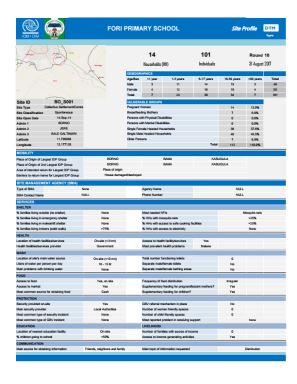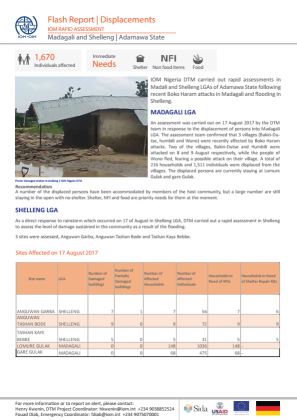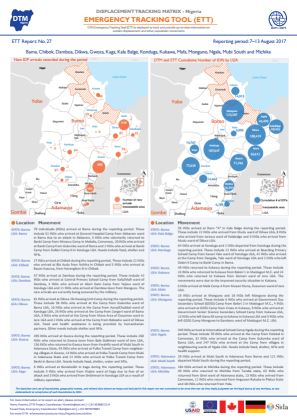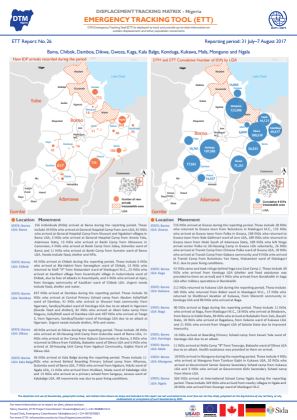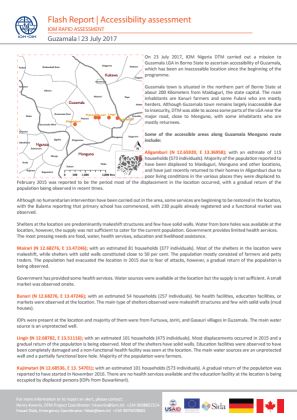-
Countries
-
Data and Analysis
-
Special Focus
-
Crisis Responses
Nigeria
Nigeria
IDPs tracked
Displacement Movements
3,340,000
IDMC 2023
Data collection round
About Nigeria
The escalation of violence between all parties in north-eastern Nigeria since 2014 has resulted in mass displacement and deprivation in the states of Adamawa, Bauchi, Borno, Gombe, Taraba and Yobe. To better understand the scope of displacement and assess the needs of affected populations, IOM has been implementing its Displacement Tracking Matrix (DTM) programme starting July 2014, in collaboration with the National Emergency Management Agency (NEMA) and State Emergency Management Agencies (SEMAs). The activities of the DTM project, which consist of conducting baseline assessments and registration for IDPs living in camps and host communities, are currently being carried out in Adamawa, Bauchi, Borno, Gombe, Taraba and Yobe.
The information collected will contribute to the provision of a comprehensive profile of the IDP population in Nigeria which will be shared with all relevant stakeholders and will contribute towards enabling the government of Nigeria and humanitarian partners identify the needs of Nigeria's displaced population and develop interventions for providing IDPs necessary assistance.
Contact
DTM Nigeria
DTMNigeria@iom.int
Current Donors
- ECHO
- BHA
- Canada
Nigeria — Taraba Site Profiles 18 (25 July — 15 August 2017)
This is a compilation of all site profiles in Taraba identified in Round 18.
Nigeria — Borno Site Profiles 18 (25 July — 15 August 2017)
This is a compilation of all site profiles in Borno identified in Round 18.
Nigeria — Adamawa Site Profiles 18 (25 July — 15 August 2017)
This document contains all Adamawa site profiles for Round 18.
Nigeria — List of Wards Assessed 18 (25 July — 15 August 2017)
1,757,288 displaced individuals (322,931 households) were identified in Round 18 DTM in Nigeria.
Nigeria — List of Displacement Sites Assessed 18 (25 July — 15 August 2017)
This document lists all the sites assessed in DTM Round 18 including the site ID, site name, state, Local Government Area, ward name, number of households and number of individuals.
Nigeria — Site Assessment Dashboard 18 (August 2017)
This Site Assessment Dashboard identified 242 camps and camp-like settings (formal and informal camps) housing and 658,841 IDPs. 61% cited tarpaulin as the most needed shelter material while 13% complained of not having portable water.
Nigeria — Displacement Dashboard 18 (August 2017)
This displacement dashboard determines the status, locations, and needs of people displaced by the ongoing conflict in Northeast Nigeria. As of 15 August 2017, the DTM has identified 1,757,288 IDPs (322,931 households) across Adamawa, Bauchi, Borno, Gombe, Taraba, and Yobe States.
Nigeria — Displacement Report 18 (August 2017)
This dispalcement report covers the period of 25 July to 15 August 2017 and includes the six most-affected states of Adamawa, Bauchi, Borno, Gombe, Taraba and Yobe.
Sep 11 2017
Nigeria — Displacement Report 18 (August 2017)
Nigeria — Emergency Tracking Tool Report 30 (28 August — 3 September 2017)
DTM Emergency Tracking Tool (ETT) is deployed to track and provide up-to-date information on sudden displacement and other population movements in: Bama, Damboa, Dikwa, Gwoza, Kala Balge, Konduga, Monguno and Ngala.
Nigeria — Flow Monitoring Dashboard 6 (1—31 August 2017)
This dashboard provides an overview of mobility patterns occurring in Nigeria’s northern States of Kano and Sokoto in August 2017. Results show that the daily average number of individuals observed at the flow monitoring point (FMP) in Sokoto decreased by 3% compared to July.
Nigeria — Emergency Tracking Tool Report 29 (22—28 August 2017)
DTM Emergency Tracking Tool (ETT) was deployed to track and provide up to date information on sudden displacement and population movements in: Bama, Damboa, Dikwa, Gubio, Gwoza, Jere, Kaga, Kala Balge, Konduga, Kukawa, Mafa, Monguno, Ngala, and Madagali.
Nigeria — Emergency Tracking Tool Report 28 (14–22 August 2017)
From 14 to 22 August 2017, arrivals were registered in the following Local Government Areas: Bama (20), Damboa (23), Dikwa (22), Gubio (20), Gwoza (738), Kaga (28), Konduga (13), Kukawa (48), Mafa (63), Monguno (42), Ngala (392), Madagali (1,511), and Shelleng (159).
Nigeria — Displacements Flash Report (17 August 2017)
An assessment was carried out on 17 August 2017 by the DTM team in response to the displacement of persons into Madagali LGA. The assessment team confirmed that 3 villages (Bakin-Dutse, humbili and Wuno) were recently affected by Boko Haram attacks.
Nigeria — Emergency Tracking Tool Report 27 (7–13 August 2017)
The DTM emergency tracking tool was deployed to track and provide up-to-date information on sudden displacement and other population movements in: Bama, Chibok, Damboa, Dikwa, Gwoza, Kaga, Kala Balge, Konduga, Kukawa, Mafa, Monguno Mubi South and Michika.
Nigeria — Emergency Tracking Tool Report 26 (31 July – 7 August 2017)
The DTM emergency tracking tool was deployed to track and provide up-to-date information on sudden displacement and other population movements in: Bama, Chibok, Damboa, Dikwa, Gwoza, Kaga, Kala Balge, Konduga, Kukawa, Mafa, Monguno and Ngala.
Nigeria — Emergency Tracking Tool Report 25 (25 July — 1 August 2017)
The DTM emergency tracking tool was deployed to track and provide up-to-date information on sudden displacement and other population movements in: Bama, Bayo, Chibok, Damboa,Dikwa, Gwoza, Jere, Kaga, Kala Balge, Konduga, Mafa, Monguno and Ngala.
Nigeria — Flow Monitoring Dashboard 5 (1—31 July, 2017)
This dashboard provides an overview of mobility patterns occurring in Nigeria’s northern States of Kano and Sokoto in July 2017. Results show that the daily average number of individuals observed at the flow monitoring point (FMP) in Kano increased by 18% compared to June.
Nigeria — Accessibility Assessment Flash Report (23 July 2017)
On 23 July 2017, IOM Nigeria DTM carried out a mission to Guzamala LGA in Borno State to ascertain accessibility of Guzamala, which has been an inaccessible location since the beginning of the programme.
Nigeria — Emergency Tracking Tool Report 24 (24 July 2017)
This DTM Emergency Tracking Tool (ETT) has been deployed to track and provide up-to-date information on sudden displacement and other population movements in Bama, Chibok, Damboa, Dikwa, Gwoza, Jere, Kaga, Kala Balge, Konduga, Mafa, Monguno and Ngala.
Nigeria — Emergency Tracking Tool Report 23 (11—17 July 2017)
This DTM Emergency Tracking Tool (ETT) has been deployed to track and provide up-to-date information on sudden displacement and other population movements in Bama, Chibok, Damboa, Dikwa, Gubio, Gwoza, Jere, Kaga, Kala Balge, Konduga, Kukawa, Kwaya Kusar, Mafa, Monguno and Ngala.
Nigeria — Displacement Report 17 (June 2017)
This report of the Round XVII Displacement Tracking Matrix (DTM) assessment by the International Organization for Migration (IOM) aims to improve understanding of the scope of displacement and the needs of affected populations in conflict-affected states of northeast Nigeria.
Jul 17 2017
Nigeria — Displacement Report 17 (June 2017)
Nigeria — New IDP Arrivals Flash Report (13 July 2017)
On July 13 2017, an assessment was carried out to ascertain the situation of the new arrivals at custom house which arrived on 12 July 2017.
Nigeria — Emergency Tracking Tool Report 22 (3—10 July 2017)
This DTM Emergency Tracking Tool (ETT) has been deployed to track and provide up-to-date information on sudden displacement and other population movements in Bama, Chibok, Damboa, Dikwa, Gubio, Gwoza, Kaga, Kala Balge, Konduga, Kukawa, Mafa, Monguno and Ngala.
Nigeria — Emergency Tracking Tool Report 21 (26 June—2 July 2017)
DTM Emergency Tracking Tool (ETT) is deployed to track and provide up-to-date information on sudden displacement and other population movements in: Bama, Chibok, Damboa, Dikwa, Gubio, Gwoza, Jere, Kaga, Kala balge, Konduga, Monguno, and Ngala.
Pagination
Pagination
- First page
- Previous page
- 1
- 2
- 3
- 4
- 5
- 6
- 7
- 8
Pagination
- First page
- Previous page
- 1
- 2
- 3
- 4
- 5
- 6
- 7



